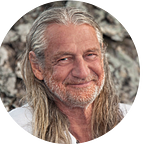Real Yoga for Real People | Mark Whitwell
Mark Whitwell | Heart of Yoga
I recently watched Ricky Gervais’ TV series After Life (2019) and loved seeing the brilliant parody of the absurd excesses of new age yoga and spirituality.
Gervais plays Tony Johnson, a British everyman who, in the aftermath of losing his wife Sarah to breast cancer, also loses all will to social nicety. In a well-meaning attempt to cheer his grieving friend up, his boss Matt drags him along to a yoga class run by a new age guru-type named Simon.
The collision course is set.
Tony immediately balks at the instructor with his tie-dye shirt, three-quarter length beige pants, mala beads, bangles and new age bromides: “Your mind is in every cell of your body. I want you to think about that,” he tells Tony condescendingly; “Shine your heart forward. Gaze into your pelvis. And look out of your third eye.”
We all know these kinds of classes!
Tony reaches breaking point when Simon pushes the idea that illness is “a state of mind” and that “if bad things have happened to you. You must have welcomed them in.”
“That’s ridiculous,” Tony says, exiting the class whilst hurling a few cutting insults at Simon.
Gervais hits the nail on the head of why most of the public is completely turned off by the yoga world. It is refreshing to have a wonderful comic cut through its dense layers of faux-spiritual nonsense. My teacher U.G. used to call it “shoddy goods on the spiritual marketplace sold to a gullible and suffering public.”
Without being imposed upon by the social and spiritual demand to be happy and positive all the time and with the help of a few good friends, Tony gradually and naturally finds his way back into the related condition — his anger, pain, and grief eventually resolves in compassion for himself and others. No mental manipulation required.
I enjoyed the show’s decision to celebrate relationship itself as the primary healing force in our lives. It is an idea that is at the heart of an actual Yoga tradition that was shown to me years ago in India. It was neither the multi-billion dollar industry of gymnastic brands and new age commodities of the west; nor the big business of spirituality and enlightenment that is exported from the east. But a sincere and actual tradition of spiritual practice, shared amongst friends, that is useful to every kind of person.
In the tradition that my teacher Tirumalai Krishnamacharya (1888–1989) and his son TKV Desikachar (1938–2016) brought forth, Yoga was taught as the practical means for each person to be intimate with themselves and others. Practices were shared between friends in one-to-one meetings and were tailored to individual needs: body type, age, health, and cultural background. The Yoga was adapted to the student and not the student to the Yoga.
How does it work?
In Yoga, we link the breath to the whole body, and the mind follows the breath automatically. The mind gets linked therefore to the extraordinary intelligence, relatedness and feeling-sensitivity of the whole body which is life itself — a perfectly functioning and connected part of Mother Nature.
As we move and breathe in these specific ways, our inherited assumption of separation (separation from ourself, others, and from life) dissolves. Our attention drops away from trying to either ‘disconnect’ and get away from it all or trying to ‘get connected’ to what we already are. Instead, we relax into our natural state of prior relatedness. The receptivity of the inhale sensitizes the front of the body to be able to receive and merge with our experience. And the strength of the exhale supports our ability to receive whatever life presents — including extremely difficult experiences like loss and grief.
In Yoga, there is a saying that “everything is sat — everything is the truth, including pain, illness, and death.” Through the careful adaptation of movement guided by the breath, we learn to merge with our experience rather than react to it. We co-operate with and participate in our emotions knowing that there is sequence to be moved through. The natural sequence of emotions is: numbness, fear, anger, pain, grief, compassion, and love. With our felt connection to the whole of life and all ‘things’ we develop the certitude that we can handle our experience however painful.
To be with our breath moves the life current through the body and mind. It is the very means of connecting to our emotional experience. The receptivity of the inhale uncovers and softens our sorrow and grief and the exhale releases what we no longer need. The breath clears the pathways of the body so that the life energy can flow in her natural directions. We release the trauma of the past so that we can keep participating fully in our lives today, especially in our relationships with one another.
The power of actual Yoga depends entirely on the breath. And yet, it is the breath that has been almost entirely ignored in the contemporary brands and styles of yoga. Without the specific breath technology that our ancestors developed all that remains, like the hilarious class in After Life, is silly spiritual ideas combined with a little bit of stretching.
I share in Gervais’ and many other peoples’ utter distaste for what the word “yoga” usually means. As the world concludes its fascination with these “shoddy goods” we can begin the work of finding out what actual Yoga really is: a beautiful practice of intimate connection to Life itself.
Read More:
